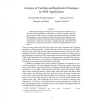Free Online Productivity Tools
i2Speak
i2Symbol
i2OCR
iTex2Img
iWeb2Print
iWeb2Shot
i2Type
iPdf2Split
iPdf2Merge
i2Bopomofo
i2Arabic
i2Style
i2Image
i2PDF
iLatex2Rtf
Sci2ools
INTERNET
2007
2007
Analysis of Caching and Replication Strategies for Web Applications
Replication and caching mechanisms are often employed to enhance the performance of Web applications. In this article, we present a qualitative and quantitative analysis of state-of-the-art replication and caching techniques used to host Web applications. Our analysis shows that the selection of best mechanism is heavily dependant on the data workload and requires careful analysis of the application characteristics. To this end, we propose a technique that may enable future Web practitioners to compare the performance of different caching/replication mechanisms. There are many reasons why Web sites can be slow and an important one is dynamic generation of Web documents. Modern Web sites such as Amazon.com and Slashdot.org do not simply deliver static pages but generate content on the fly each time a request is received, so that the pages can be customized for each user. Clearly, generating a Web page in response to every request takes more time than simply fetching static HTML pages ...
INTERNET 2007 | Page | Web Pages | Web Sites |
| Added | 15 Dec 2010 |
| Updated | 15 Dec 2010 |
| Type | Journal |
| Year | 2007 |
| Where | INTERNET |
| Authors | Swaminathan Sivasubramanian, Guillaume Pierre, Maarten van Steen, Gustavo Alonso |
Comments (0)

